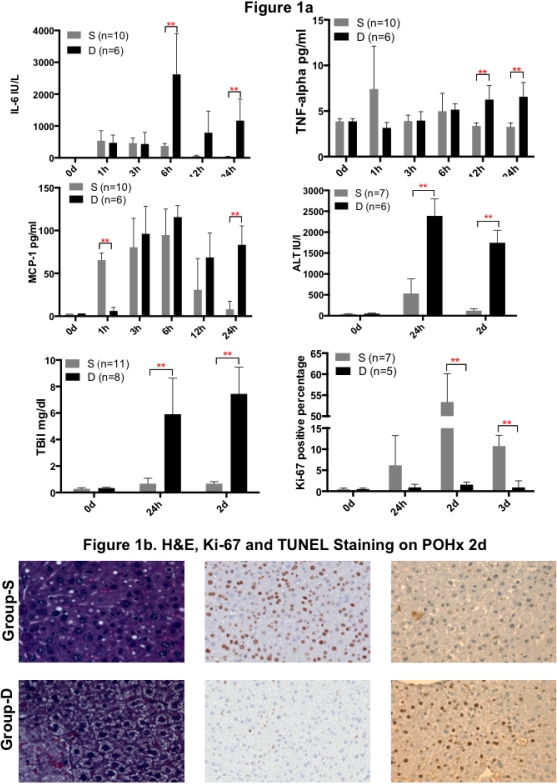Cytokine Storm in Acute Post-Hepatectmy Phase Associates with Liver Injury and Impaired Liver Regeneration.
1Transplantation Division, Massachusetts General Hospital, Boston, MA
2Department of Hepatobiliary Surgery, Chinese PLA General Hospital, Beijing, China.
Meeting: 2016 American Transplant Congress
Abstract number: A203
Keywords: Apoptosis, Liver failure, Liver transplantation, Post-operative complications
Session Information
Session Name: Poster Session A: Living Donor Liver Transplantation
Session Type: Poster Session
Date: Saturday, June 11, 2016
Session Time: 5:30pm-7:30pm
 Presentation Time: 5:30pm-7:30pm
Presentation Time: 5:30pm-7:30pm
Location: Halls C&D
Background Posthepatectomy liver failure and its transplant counterpart, small-for-size syndrome, remain poorly understood. Large increases in IL-6 are associated with poor allograft function and IL-6 hyperstimulation also appears to delay liver regeneration, in spite of IL-6 being important in initiating hepatocyte replication. We therefore looked at the relationship between serum IL-6 and liver regeneration in a mouse hepatectomy model.
Method 67% of mice die following two-thirds hepatectomy. Utilizing a non-invasive scoring system that accurately predicts survival following hepatectomy by 12h post-op, we were able to prospectively assign mice to survival (S) or death (D). We then measured serum IL-6, TNF-α, MCP-1 and liver function tests, as well as taking liver tissue for H&E, Ki-67, and TUNEL staining.
Results Although all animals had increased IL-6 levels post-op, IL-6 levels of D animals were much higher than S animals by 6 hours post-hepatectomy (2251±581 vs. 371±129, P=0.003). TNF-α and MCP-1 levels lagged and became higher in D animals 24 hours post-hepatectomy. Serum ALT did not become higher in D animals until 2 days and TBil at 24 hours. D animals had more severe histologic changes of vacuolization and necrosis, associated with fewer Ki-67+ cells (1.6±0.4% vs. 52.6±7.2% of Ki-67+ cells on 2d, P<0.001) and more TUNEL+ cells. 
Conclusion Significantly higher IL-6 levels in animals predicted to die post-hepatectomy preceded elevation of liver function tests and other inflammatory markers, associated with more severe hepatocyte injury and apoptosis, and decreased hepatocyte replication. Experiments are underway to test the therapeutic value of modulating IL-6 and other inflammatory cytokine level post-hepatectomy.
CITATION INFORMATION: Xu Y, Navarro-Alvarez N, Dong J, Markmann J, Yeh H. Cytokine Storm in Acute Post-Hepatectmy Phase Associates with Liver Injury and Impaired Liver Regeneration. Am J Transplant. 2016;16 (suppl 3).
To cite this abstract in AMA style:
Xu Y, Navarro-Alvarez N, Dong J, Markmann J, Yeh H. Cytokine Storm in Acute Post-Hepatectmy Phase Associates with Liver Injury and Impaired Liver Regeneration. [abstract]. Am J Transplant. 2016; 16 (suppl 3). https://atcmeetingabstracts.com/abstract/cytokine-storm-in-acute-post-hepatectmy-phase-associates-with-liver-injury-and-impaired-liver-regeneration/. Accessed December 29, 2025.« Back to 2016 American Transplant Congress
